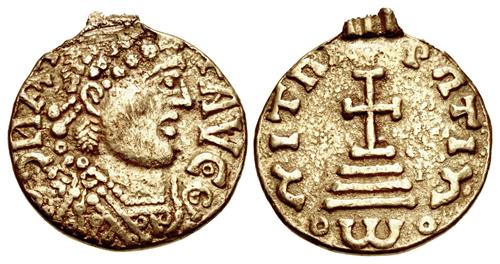|
ANGLO-SAXON, Early Period. Mid 7th century. AV Solidus (18mm, 3.17 g, 12h). Cross on Steps type. (retrograde C)ИAT TAVC, diademed and cuirassed bust right, of late Roman style / (retrograde n)ITnT P(retrograde n)TIn, cross set on three steps, of Byzantine style; oωo in exergue. Grierson, New 2/1 = Stewart, Anglo-Saxon A.93/92 (same obv./rev. dies); MEC 8 table 2, 1, and pl. 1, 1 = MEC 1, 665 = SCBI 1 (Fitzwilliam), 217 (same obv. die); SCBI 68 (Lyon), 1 (same dies) = EMC 1068.0001; North 28/1 (same obv. die as illustration); SCBC 752. PAS KENT-5E6A92 (this coin). Some edge loss, trace of mount at top (as on all examples of this type). Good VF. A highly important and extremely rare coin, one of five known and the only example available to commerce.
Found Hoo Peninsula, Medway, Kent, 8 October 2017.
Our present knowledge of the coinage produced by the earliest English speaking peoples is derived from a corpus of some two hundred fractional gold thrymsas, or tremisses, and only eight examples of the full gold solidus. Five of these solidi, including the piece offered here, are of the ‘Cross on steps’ type, a design that pairs on the obverse a diademed and cuirassed bust facing right derived from Roman issues of the 4th century, and a depiction of the True Cross, introduced to the Byzantine coinage under the Emperor Heraclius in the early 7th century, on the reverse.
All five solidi of the ‘Cross on steps’ type, including the present specimen, bear signs of having had a suspension mount attached. The suggestion that these coins were made merely for ornamental purposes has been rejected in recent publications by Lyon and Naismith as the type is known from two sets of dies and the different gold content of the suspension loops indicates that they were not mounted at the same time of manufacture. Instead these exceedingly rare coins represent the largest denomination produced during the earliest period of Anglo-Saxon coin production and must have constituted a considerable store of wealth. As such, their circulation must have been limited to the highest echelons of society.
The solidus offered here is the only example available to commerce. The seven other known Anglo-Saxon solidi are part of, or on permanent loan to, institutional collections. The present corpus of the five known examples of the ‘Cross on steps’ type:
1. Dies A/1.
(a) Nuremberg, Germanisches National-Museum (Münzsammlung no. 12372). Grierson, New 1a = Stewart, Anglo-Saxon 92a.
(b) Paris, Bibliotheque Nationale. Grierson, New 1b = Stewart, Anglo-Saxon 92b.
2. Dies B/1.
(a) S. Lyon Collection (SCBI 68 [Lyon], 1 [EMC 1068.0001]).
(b) The present coin
3. Dies B/2.
(a) Cambridge, Fitzwilliam Museum (MEC 8, 1 = MEC 1, 665 = SCBI 1 [Fitzwilliam], 217). Grierson, New 2 = Stewart, Anglo-Saxon 93a.
The final winners of all Triton XXIV lots will be determined during the live online sale that will be held on 19-20 January 2021. This lot is in Session Four, which begins 20 January 2021 at 2 PM ET.
Winning bids are subject to a 20% buyer's fee for bids placed on this website and 22.50% for all others.
We recognize that our users may have various Internet Browsers and Operating Systems. We like our visitors to have the best possible experience when using our bidding platform. However, we do recognize that it is impossible to develop applications that work identically, efficiently and effectively on all web browsers. The CNG bidding platform supports Mozilla Firefox (version 60+) and Chrome (version 67+).
|
